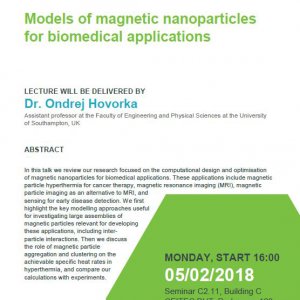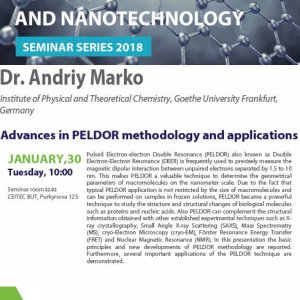
| Telefon: |
+420532290448 |
| E-mail: |
|
| Kancelář: |
|

| Telefon: |
+420532290351 |
| E-mail: |
|
| Kancelář: |
|
Research areas
-
Experimental studies of relationships between microstructure and physical properties of materials.
-
Quantum-mechanical studies of electronic, magnetic and optical properties of ordered and disordered media.
-
Atomistic studies of stress relaxations in heteroepitaxial films, on surfaces and at interfaces.
-
Mesoscopic models of self-organization and pattern formation in correlated microstructural domains.
-
Thermodynamic models for entropically stabilized ordered high-temperature alloys.
-
Linking atomistic studies of incipient plasticity with direct experimental measurements.
-
Calculations of minimum energy pathways and sampling of the density of states of large systems.
-
Computational studies of dislocation loops in irradiated materials.
-
Self-organized criticality and scale invariance in systems with long range interactions.
-
Electron microscopy of extended defects and its coupling with image simulations of HREM contrast.
-
Computational fracture mechanics and fatigue of metals and polymers.
-
Experimental measurements of physical properties of metals and polymer-metal composites.
-
Modelling of phase diagrams of nanoalloys with complex metallic phases.
Main objectives
Bridging the description of structure-property relationships across many length and time scales
Physical properties of materials often change drastically when the surface to volume ratio of the material increases beyond certain limits. This leads to many interesting phenomena not observable in bulk materials, such as dislocation starvation in deformed nanopillars, strong surface reconstructions around screw dislocations in epitaxial films or free-standing foils, enhanced mobility of prismatic dislocation loops in irradiated materials and the associated need for corrections to the defect density when studied in TEM, existence of two-dimensional electron gas in III-V films grown heteroepitaxially on lattice-mismatched substrates and the onset of polarization through the foil, and the like. Our objective is to unravel the mechanisms that are responsible for these phenomena and develop models that can predict the behavior of the material across a wide range of length and time scales with a limited input from experimental measurements and quantum mechanical calculations.
Continuum-level predictions of structural stability and resistance to fracture and fatigue
Understanding the mechanisms leading to unstable crack growth and predicting the residual lifetime under current environmental conditions is a crucial step within computer aided materials design. Our aim is to develop accurate finite element models that include the salient physics of the problem and use these models to assess the stability of a wide range of structural components made of metals (both anisotropic single crystals and random polycrystals), polymers, polymer-polymer and polymer-metal composites. The obtained distribution of internal stresses will serve as a guideline to the optimized design of these components under given working conditions.
Experimental studies of functional properties of nanostructures
The objective is to elucidate how the heat and mechanical treatments affect the crystal structure, electrical and magnetic properties of micro and nanostructures. Most of these results are obtained by employing Mössbauer spectroscopy and the PPMS system. Our advanced measurements and optimizations of the functional properties of nanostructures for nanoelectronics, nanophotonics and (bio)sensing, and their correlations with structural and physical parameters of nanostructures suggest novel nanostructured materials with unique properties not observable in conventional materials.
Content of research
Elucidation of the mechanism of strain relief in large-misfit heterostructures
Large-misfit heterostructures are used to fabricate modern optoelectronic devices such as light emitting diodes (LED), laser diodes (LD) and high electron mobility transistors (HEMT). The main open question is the origin of the large density of threading dislocations and the understanding why these defects are not deleterious to the optical properties of the device as compared to GaAs-based devices, where even a modest density of threading dislocations completely quenches the luminescence of LEDs and LDs. We are mostly interested in understanding the origin of threading dislocations in AlN/Si heterostructures fabricated by atomic layer deposition (ALD) and molecular beam epitaxy (MBE) techniques and investigated using a combination of state-of-the-art atomistics calculations and transmission electron microscopy (TEM). An important part of this research will be the development of a new description of bonding in the Al-N-Si system by a combination of Tersoff potential, electrostatic interaction and self-consistently calculated distribution of Madelung effective charges on individual ions using the QEq method.
Development of multiscale models of plasticity based on atomic-level studies of dislocations
Molecular statics simulations are used to determine the core structures of screw dislocations and their changes in the vicinity of surfaces, interfaces, other lattice defects and under externally applied load. These details are implemented into constitutive laws which form the basis of the thermodynamic description of plasticity. The main application of this theory is a wide range of materials whose plastic flow is not governed by the Schmid law (bcc metals, hcp metals deforming by non-basal slip, intermetallics and certain nuclear materials). This theoretical description will be implemented into the finite element code ANSYS and used to investigate which atomic-level features associated with isolated dislocations are retained after coarse-graining and after Taylor averaging over all grain orientations. In parallel with these theoretical developments, we have recently initiated an experimental program whose objective is to elucidate the anomalous slip in single crystals of all non-magnetic bcc metals (V, Nb, Mo, Ta, W). These experiments will be made on millimeter-sized samples at 77 and 300 K and will map the response of each materials under tension and compression for all orientations throughout the standard stereographic triangle.
Understanding the phase stability, diffusion and plasticity of high-entropy alloys
It has been proposed that quaternary and higher order solid solution alloys can be stabilized as single phases due to a large configurational entropy that arises from equiatomic mixing of four or more chemical elements. While the individual pure components have typically very different crystal structures and ordering of magnetic moments, their mixture is a random alloy, typically with face centered or body centered cubic crystal structure, and no detectable magnetic moment. Our research effort focuses on following open questions:
Does the configurational entropy of these materials overcome the destabilizing effect of the enthalpy terms and thus stabilize the fcc or bcc crystal structure even though this is not the ground state for many of the constituent materials? Do the resulting solid solutions exhibit sufficient thermodynamic stabilities during subsequent thermal and mechanical exposures? Or, the system decomposes into a phase mixture with sufficiently long aging time?
Is the kinetics of diffusion in the corresponding crystal lattices influenced by the complex composition with consequences for high temperature plasticity of the alloys governed by diffusion-controlled processes?
How can we rationalize the deformation resistance of these alloys at low temperatures in terms of a dislocation core structure and energy barriers related to dislocation displacements?
The motion of dislocations in these materials will be described by a simplified thermodynamic model of dislocation glide that takes into account the randomness of the environment in which the dislocations move. The core structures, stability, activation barriers and kinetics of dislocations will be studied using molecular statics combined with the saddle-point search algorithms, which will serve to interpret the observations made using electron microscopy.
Sub-angström imaging of lattice defects by a combination of atomistic simulations and HREM
The point-wise resolution of the best aberration-corrected HREM is around 0.5 Å, which is still insufficient to identify the structures of dislocation cores in most technologically important materials such as Ta or W, where the largest displacement of core atoms is around 0.1 Å. The objective of this research is to combine the simulations of image contrast based on atomistically calculated structures of a few selected defects with direct HREM observations to develop additional “software aberration correctors” which will further narrow peak broadenings obtained from HREM. These additional corrections will allow direct imaging of unknown structures of lattice defects and their modifications due to surfaces and interfaces with other materials. These developments will open the possibility to understand how large epitaxial strain in III-nitride/Si heterostructures affect the core structure and mobility of mixed and threading dislocations and thus to boosting the optoelectronic properties of devices utilizing these materials.
Finite element characterization of the strength of polymer-polymer and polymer-metal composites
The steadily increasing interest in replacing metallic parts by more lightweight polymers and polymer-metal composites raises a number of questions about structural stability under slow crack growth. The main goal of this project is to develop methodology that would be capable of predicting the onset of slow crack propagation in polymers under a wide range of loading conditions, temperatures and also taking into account residual stresses. The residual lifetime of the structure will be obtained by considering a quasi-brittle behavior of these materials and quantifying the fracture mechanics parameters for a range of crack geometries and combinations of materials parameters. This large knowledge base and the predictions made from it will be used to find correlations between experimental data and predictions of the numerical model and thus to find the optimal combinations of materials parameters that guarantee structural stability under given working conditions. The obtained results will estimate the effect of residual stresses, variations of materials properties, understanding the roles of materials nonhomogenities and ambient conditions on the residual lifetime of these polymers.
Advanced measurements of the functional properties of nanostructures
The main goal is to find a correlation between the properties and the geometrical and structural parameters of nanostructures and to use this knowledge for feedback in the technology of their preparation and for various applications. Magnetic properties and electrical/thermal transport properties of nanostructures, ordered nanostructures, ultrathin layered structures, and high-temperature super-conductors will be determined experimentally in the temperature range of 2-300 K on a Physical Property Measuring System (PPMS, Quantum Design), which enables measurements in applied magnetic fields up to 9 T. A vibrating sample magnetometer (VSM) will be used to investigate magnetic properties at high temperatures (293-1093 K). Structural and magnetic properties of Fe-based nanostructures will be studied using Mössbauer spectroscopy at low (5-293 K) and high (293-1093 K) temperatures.
Theoretical predictions of phase diagrams of nanoalloys
Unlike in the case of bulk systems, surface stresses play an important role in determination of phase diagrams of nanoalloys. In these materials, the contribution of surface stress to the overall Gibbsfree energy ceases to be negligible and affects the melting temperatures of the constituents as well as the change of temperature of invariant thermodynamic reactions. The aims are to model phase diagrams of nanoalloys with variable particle sizes and to develop suitable models that properly describe the effects of surface stresses of the constituent elements and their intermetallics on the phase diagrams. These predictions are checked against available experimental data.











